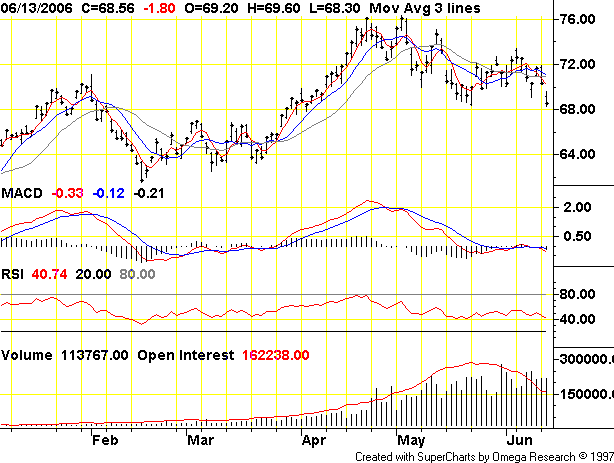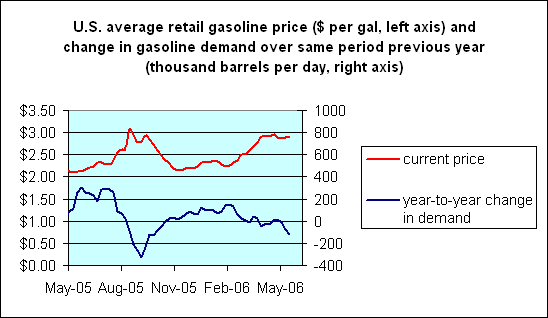Five weeks ago, I wondered whether oil prices might have peaked at $75 a barrel. Time to take a look at some of the data that have come in since then.

|
The graph below plots the weekly average U.S. retail gasoline price (red line, units on left axis) and the average U.S. gasoline demand over the four weeks ending at the indicated date minus the average demand of the corresponding 4-week period of the preceding year (blue line, units on right axis). For the past year, we’ve seen a consistent pattern– whenever the retail price is above $2.50 per gallon, U.S. gasoline use has been kept at or below the levels of the previous year. Motley Fool notes related developments in Asia. I continue to believe that $70 oil generates lots of incentive for consumers to
change their
habits. For this reason, I have a hard time seeing strong demand as the factor supporting an oil price above $70 a barrel.

|
On the supply side, most of the discussion in the financial press seems to focus on Iran or Iraq. That is understandable, given the drama of geopolitical events unfolding in those locations. But from the perspective of global oil supplies, I’m inclined to pay attention to two other suppliers– Nigeria and Saudi Arabia.
Conflicts in Nigeria reduced that country’s production by over 300,000 barrels a day in March compared with where it had been in December. More recent attacks may have increased that loss to 800,000 barrels a day. Remembering the scale on the right-hand axis in the figure above, it takes a lot of conservation to try to make that up.
And the Saudis yesterday announced their intention to increase capacity to 12 million barrels a day (mbd) by 2009, which would be 2.5 mbd above the 9.5 mbd they have been pumping for the last year. On the other hand, if one looks at actions rather than words, they apparently only produced 9.1 mbd in April, which would be a production decrease of 400,000 barrels a day, and this could have dropped further to 9.05 mbd in May. I’m surprised that nobody else is talking about the latter development– perhaps like me, they’re not sure just what it all means. But if, for whatever reason, Saudi production is headed down rather than up over the near future, it will be a much bigger story than any of the others. All the more reason it would be nice to see some more people doing some investigating here.
Technorati Tags: gas prices,
gasoline prices,
oil,
oil prices,
oil demand,
oil supply
Jim,
Glad to see that you are keeping the focus on where it should be, Nigeria and Saudi Arabia. Your earlier post on Saudi already noted how murky the managers of their operations are and how hard it is to tell what is really going on. The really big bottom line, both for Saudi and for the whole world, is the world’s largest pool, al Ghawar, there. If it is starting to decline, there is not much that anybody will be able to do about it. That will be the peak. Of course, given their claims of increasing capacity, who knows?
As a side note to conservation, conservation will reduce total demand, it seems to me, only in a system closed to new oil users and new oil uses. Conservation otherwise lowers barriers to entry and use for such users and uses. Perhaps unintuitively, conservation actually therefore should increase demand, as I think studies show it does.
The price of crude is finally looking vulnerable.
Don’t leave inventories out of the analysis, since they may be the real story here – if the Saudi’s have truly cut production, it’s because inventories all over the world are relatively high and central bank tightening potentially raises the cost of carrying all the excess crude.
There are lots of stories going around about the 20 million barrels of Iranian crude “on the pond” headed for SE Asia with no buyers in sight.
It’s a bit of a mystery to me how all the other industrial commodities could get clobbered so hard over the past 4 weeks and yet the price of crude has held in darn near $70 per barrel, trading on air, it is . . . . . .
Has anyone bothered to look deeper into the EIA DOE data for U.S. gasoline requirements? Seriously.
1. Refined gasoline inventories are very high.
2. Refinery capacity in Texas is running significantly lower than in Louisiana.
3. There appears to be no evidence that refining capacity is being pushed anywhere near its operating limit. Not even close.
4. There appears to be no shortage of available crude oil.
Six hours of refining capacity vs. operating analysis leads me to believe that there is no shortage of available capability where in expressed in terms of capacity or demand requirements. It’s simply not the case.
—-
Global refining capacity has supposedly increased on the order of 2.8 percent since Jan 2006, exceeding global demand growth requirements.
What’s the rest of the global demand story?
Regarding those flush (above-ground, ahem) inventories, with futures in contango, better fill the tanks, ey?
Why don’t you look at the lack of arbitrage between futures and physical?
You have reports all over that confirm there are no buyers for REAL “wet barrels” of oil. Yet “paper barrels” trade in their own world, like some stock would.
Why wouldn’t a player just use the extra capacity to bring the market down?
Have a look here:
http://dhatz.blogspot.com/2006/06/oil-to-38657-per-barrel.html
Surely the rise in oil prices is a classic case of market forces in action & supply and demand for a commodity? If OPEC/SA think they have plenty of oil, why dont they offer it to the market at reduced cost, say $40 per barrel- especially for those African countries that can’t afford the present US$70 per barrel price? dhatz- yes there are 2 million barrels of OPEC surplus, but it is all SA heavy crude that no refiner wnats to buy- they want sweet, sweet light crude.
the problem the saudis have is that most of their spare capacity is heavy sour crude which western refineries can’t process effectively. they are investing in increasing production capacity in sweeter, lighter crudes – they have a couple of discoveries which were shut in or undeveloped which they are now bringing onstream – and they are also investing in refining capacity at home, and in joint ventures with asian countries, which can deal with the heavy sours. so it’s not entirely disingenuous when they say that they’re finding it hard to sell their oil, though they do always keep their cards close to the chest.
Mainstream media isn’t going to look at those things because, I believe, they think it’s too complicated for the general public. Either that or they don’t know what to look at.
If the Saudis are reducing production, is some other country making up the difference or is this part of the reason for increased prices?
Neither. Read dhatz’s link. His info is solid.
Does anyone find it interesting that OPEC’s production is less than their quotas? If the price of oil is unsustainably high why isn’t someone cheating? Or has production peaked?
It’s because there is no DEMAND for PHYSICAL (“wet barrels”). OPEC has been stating this for quite some time. If they did pump it from the ground and there is no buyer, what can they do, build tanks to store it above-ground?